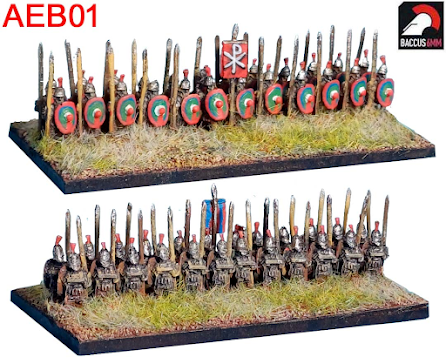Or in this case 'The Moor the Merrier' or Mauri, it's the North West African chaps who are the focus of this post. I was looking through my lead pile and realised that I had bought a couple or three packs of Moorish Infantry. These were used for various Dark Age types like the Welsh Princedoms and Dal Radian Scots. The castings are bare legged and only have a tunic so they can be pressed into service as any number of lower class skirmishing foot types in that period. I have sufficient of those for the time being so I decided to use them as Mr Berry intended, well I had quite a lot of them more (or should that be moor) than enough to cover the DBA3 infantry requirements for a Later Moorish army.
With very little variation in clothing choices, which meant a restricted palette, painting looked like it was going to be easy. White(ish) tunic, some dyed cloaks dark skin tone and then just animal skin shields in a mid brown, hair in a dark colour and weapons. Well at least it it looked easy! Moors didn't have the really dark skins of Sub-Saharan Africans so getting that shade right took a few goes and as for the white tunics....Arghh! White is one of those colours which is difficult to shade (I really must try a contrast type white paint at some point) and it took me a few attempts before I came up with an system that I was happy with.
I started with a white undercoat courtesy of Halfords ever reliable rattle can automotive primer. I pre-shading on that but didn't like the contrast it gave. So I had a cup of tea and a bit of a think ( but didn't take off any handles or things what hold the candles*) and decided on a new approach. I painted all the tunics in Vallejo Bone white which is more of a pale coffee brown and all the flesh in Vallejo German Camouflage Brown a darker mid brown with a hint of something else in the mix possibly blue. Only then did I apply a thinned wash of GW Agrax Earth Shade. After which I dry brushed the tunics in Vallejo Ivory and then picked out some high spots in Vallejo Pure White. It sounds like a lot of work but it doesn't take as long as you might think. Adding some variations between black and chocolate brown for hair and some pale brown for javelin shafts pretty much completed the main paining. A coat of varnish and the final touch of silver for spear points and bronze to officers' helmets and that was job done.
 |
| A gratuitous close up so you can see the final effect on those pesky tunics |
Basing is my usual block paving sand and fine flock patches. I used less flock than normal as Moors live in the Semi-Arid lands of North West Africa. I will have to order some Moorish cavalry next time I'm buying from Baccus, then the Moors can be off to the races (see what I did there?). I have completed 44 of the infantry to date and have a further 36 on the painting table nearing completion.
 |
| A few more Moors (sorry I couldn't resist it), there are more to come (sorry, not sorry) |
The Moors are an interesting army in DBA, a general who is either cavalry or light cavalry, five Light Cavalry and six javelin armed foot who can be a mix of light infantry or fast auxilia. Not a lot of punch but a whole lot of nuisance value.
As an aside, and I may already have posted about this. I read something on a blog a while ago which has been a game changer in terms of brush care. The occasional use of alcohol based hand sanitiser gel to clean brushes! The gel means it sticks to the brush and it removes acrylic paint a treat, being clear also means you can see what is being shifted too. It doesn't seem to damage the glue holding the hair in place, although I take the precaution of washing them out in warm water with a drop of Mrs E's shampoo in it afterwards. After a second rinse they get a bit of hair conditioner then a final rinse and dry.
* For the education of younger readers go look for Bernard Cribbins' song "Right Said Fred". It's a tale of the trials and tribulations of two removal men. As an aside we had a second hand upright piano when I was very young that had both handles and things what held candles! Life eh?
Edited 24 November 2024 to remove some typos I spotted


